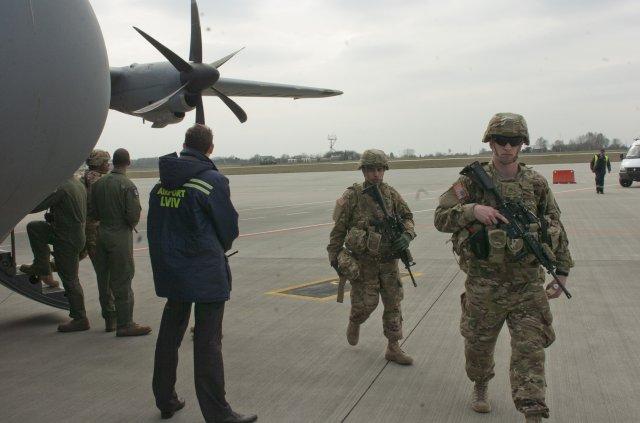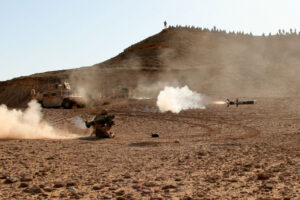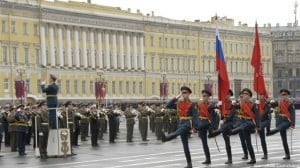
US 173rd Airborne soldiers arrive in Lviv to train the Ukrainian National Guard.
PENTAGON: What would World War III look like? Ask a Ukrainian.
In their war against Russia, Ukrainian troops have endured artillery bombardments like nothing Americans have seen since World War II. Russian electronic attacks against radio communications are like nothing the US has seen — ever. So even as Washington debates further training — and perhaps arming — the Ukrainians, the top Army commander in Europe said today, they have important lessons to teach us. Lt. Gen. Ben Hodges was too polite to say it out loud, but Ukraine is teaching us what it takes to fight the Russians — or anyone else well-armed — in a large-scale ground war.
“All of these guys are veterans,” said Hodges, speaking of the Ukrainian National Guard troops now being trained by the American 173rd Airborne Brigade. “In fact,” Hodges told reporters here today, “I was talking to [US] noncommissioned officers who’ve been with the Ukrainians, and they were like, ‘wow, these guys, they’ve done stuff we’ve never seen, [never] been exposed to that level of violence.’ So we’ve actually learned a lot from them.”
What we’re learning about is the nature of the next war. Russia’s implausibly deniable operations in Ukraine — where it insists only a few good-hearted volunteers are helping local separatists against Kiev — are often cited as a case of “hybrid war,” blending conventional and guerrilla strategies. Russia certainly has used irregular warfare, arming local proxies and sending special forces without insignia, the “Little Green Men,” to seize Crimea. But equally important to the mix are high-intensity tactics like massed artillery, jamming, and tanks, which US forces haven’t had to face for years.
It’s the threat of Russian armored vehicles, in particular, that lead many in Congress to argue the Ukrainians need American anti-tank weapons, such as the Javelin missile.
Hodges demurred when asked whether the US should provide “lethal aid” to the Ukrainians. The chairman-designate of the Joint Chiefs, Gen. Joseph Dunford, told the Senate Armed Services Committee that arming Ukraine would be “reasonable.” And he made it clear it would necessary for the Ukrainians to stop the Russians. “Frankly,” the Marine Corps four-star said, “without that kind of support, they are not going to be able to defend themselves against Russian aggression.”

A Marine fires a Javelin anti-tank missile.
The Next Big Push?
Hodges does not expect a major Russian offensive in the near future, though he hedged quite a bit. About nine to 12 “battalion tactical groups” remain near the border city of Rostov at any given time, he said, and they could move west at will. Those forces have been in place for months, he said, and there’s no sign they’re about to move.
Hodges downplayed the idea of another major offensive on the southern front, against Marioupol. That strategic port blocks the land route between Russia proper and occupied Crimea. Given the degree of Ukrainian resistance the last time, he said, the Russians would have to pour so much professional military firepower into the fight — including airstrikes — that their last shred of deniability would be gone.
“That would be such a huge fight that it would be impossible for the rebels to do by themselves,” Hodges said. “That would remove any facade of ‘there’s no Russian participation.'”
So at the moment, the violence is low-level — though no less lethal for those in the wrong place at the wrong time. The Ukrainians report two to five dead every day, Hodges said, from small arms, artillery rockets, and “everything in between.” The Russian-backed separatists have also started planting improvised explosive devices (IEDs) in civilian areas, the general added, openly puzzled at the strategic logic.
“What would be the point of doing that?” Hodges asked. “Why would you leave things like this around schools?”
Experts have long expected IEDs to proliferate around the world, given their effectiveness against US troops. Iraqi and Afghan insurgents started using roadside bombs in place of conventional artillery, which they lacked. That’s not the Russian-backed separatists’ problem.
The supply convoys moving across the Russo-Ukrainian border, Hodges said, are carrying “tons and tons of rocket artillery ammunition. I mean, it’s massive amounts — not something that was captured from the Ukrainians or being manufactured in basements,” as the Russians like to claim.
One of the most valuable items of equipment the US has provided Ukraine is a counter-mortar radar, designed to detect incoming rounds and calculate where they’re coming from. While Hodges carefully declined to discuss Ukrainian tactics, he said they have used the radars in ways that the Americans hadn’t realized was possible. It’s so successful that the Russians have made a major effort to destroy them.
Massed artillery has been a Russian tradition since World War II. During the Cold War, they added expertise in electronic warfare: jamming, intercepting, and deceiving radio and radars. US Army electronic warfare remains limited to short-range jammers to deactivate roadside bombs, with drone-mounted EW envisioned for the future. The Russians, however, have an array of ” vehicle-based systems and other platforms that can either jam or disrupt or intercept,” which they employed in Crimea, Hodges said. “We’re learning from that, we’re watching how the Ukrainians have responded.”

The West’s Next Steps
Operating under electronic attack is also part of the training program the 173rd Airborne is teaching to Ukrainian troops outside Lviv — on the far side of Ukraine from the fighting. Currently, just over 300 US Airborne soldiers are teaching a like number of Ukrainian National Guard soldiers. The first of these Interior Ministry-controlled battalions has already finished the program, a second is in progress, and a third will be completed by November 15.
At that point, the US may start training Ukrainian regular army soldiers and commandos, which fall under the Ministry of Defense. “A final decision has not been made on that,” said Hodges. “We probably are getting close to the time where a decision would have to be made” to continue the training without interruption in November.
Pressed to share his recommendation, Hodges said only that “I think the training is a very effective way to help them …. that doesn’t require necessarily providing weapons. But again, I can understand why there are different views.”
What’s crucial is to keep the NATO alliance and the European Union united, Hodges emphasized repeatedly. (In other words, that means going slowly on any measures, such as arming Ukraine, which might unnerve the more pacifistic nations). There needs to be consensus, Hodges said, on “What is the strategy? What’s the end state that we want to get to?” — and when.
“Some nations in Europe have a very long-term view,” Hodges said. “They’ll talk about, ‘well, you know, Germany was divided for 50 years before it came back together.’ I don’t know that this [Ukraine] is the same kind of thing.”
Questions hang over UK’s new, ambitious defense spending plan: Analysts
Such is the scale of British Army acquisition problems alone that they could not be resolved if the UK moved to a long term spending settlement of even 4 percent GDP, an expert told British lawmakers.


























